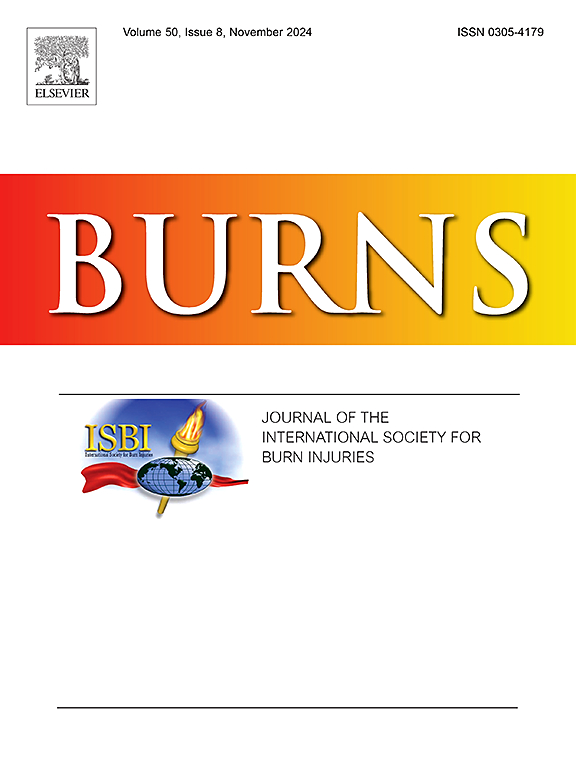亚洲酸通过抑制STAT3激活抑制瘢痕疙瘩成纤维细胞迁移和胶原沉积
IF 2.9
3区 医学
Q2 CRITICAL CARE MEDICINE
引用次数: 0
摘要
本研究探讨了积雪酸(AA)对瘢痕疙瘩成纤维细胞(KFs)的药理作用,并阐明其在瘢痕疙瘩发病中的作用机制。方法分离人KFs原代,扩增进行实验分析。通过细胞划痕法和博伊登室法评价细胞迁移能力。免疫荧光染色定量α-平滑肌肌动蛋白(α-SMA)在aa处理的KFs中的表达,Western blot检测I型胶原(Col-I)、α-SMA、STAT3和磷酸化STAT3 (p-STAT3)蛋白水平。使用Colivelin TFA(一种STAT3激动剂)在KFs中诱导STAT3激活,随后使用平行方法评估迁移行为和蛋白表达谱。结果saa处理显著抑制KFs的生存能力和迁移能力,并下调col - 1、α-SMA和p-STAT3的表达。通过Colivelin TFA激活STAT3部分恢复了aa诱导的KF迁移和Col-I表达的抑制。结论saa可显著调节KFs的迁移能力和细胞外基质(ECM)相关蛋白的表达,STAT3信号通路参与了这一调控机制。这些发现表明,AA的抗纤维化作用是通过STAT3信号通路介导的。本文章由计算机程序翻译,如有差异,请以英文原文为准。
Asiatic acid inhibits keloid fibroblast migration and collagen deposition via suppression of STAT3 activation
Background
This study investigated the pharmacological effects of asiatic acid (AA) on keloid fibroblasts (KFs) and elucidated its therapeutic mechanisms in keloid pathogenesis.
Methods
Primary human KFs were isolated and expanded for experimental analysis. Cell migration capacity was evaluated through cell scratch assay and Boyden chamber assay. Immunofluorescence staining was performed to quantify α-smooth muscle actin (α-SMA) expression in AA-treated KFs, while Western blot assessed collagen type I (Col-I), α-SMA, STAT3, and phosphorylated STAT3 (p-STAT3) protein levels. STAT3 activation was pharmacologically induced in KFs using Colivelin TFA (a STAT3 agonist), with subsequent evaluation of migratory behavior and protein expression profiles using parallel methodologies.
Results
AA treatment significantly inhibited the viability and migratory capacity of KFs, accompanied by downregulation of Col-I, α-SMA, and p-STAT3 expression. Pharmacological activation of STAT3 via Colivelin TFA partially rescued AA-induced suppression of KF migration and Col-I expression.
Conclusions
AA significantly modulates the migratory capacity and extracellular matrix (ECM)-related protein expression in KFs, with the STAT3 signaling pathway implicated in this regulatory mechanism. These findings indicate that the anti-fibrotic effects of AA are mediated through STAT3 signaling.
求助全文
通过发布文献求助,成功后即可免费获取论文全文。
去求助
来源期刊

Burns
医学-皮肤病学
CiteScore
4.50
自引率
18.50%
发文量
304
审稿时长
72 days
期刊介绍:
Burns aims to foster the exchange of information among all engaged in preventing and treating the effects of burns. The journal focuses on clinical, scientific and social aspects of these injuries and covers the prevention of the injury, the epidemiology of such injuries and all aspects of treatment including development of new techniques and technologies and verification of existing ones. Regular features include clinical and scientific papers, state of the art reviews and descriptions of burn-care in practice.
Topics covered by Burns include: the effects of smoke on man and animals, their tissues and cells; the responses to and treatment of patients and animals with chemical injuries to the skin; the biological and clinical effects of cold injuries; surgical techniques which are, or may be relevant to the treatment of burned patients during the acute or reconstructive phase following injury; well controlled laboratory studies of the effectiveness of anti-microbial agents on infection and new materials on scarring and healing; inflammatory responses to injury, effectiveness of related agents and other compounds used to modify the physiological and cellular responses to the injury; experimental studies of burns and the outcome of burn wound healing; regenerative medicine concerning the skin.
 求助内容:
求助内容: 应助结果提醒方式:
应助结果提醒方式:


